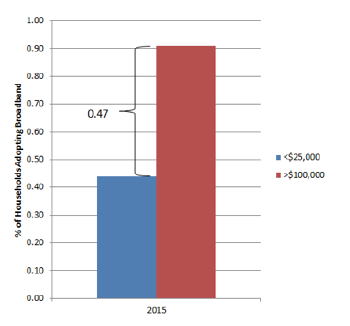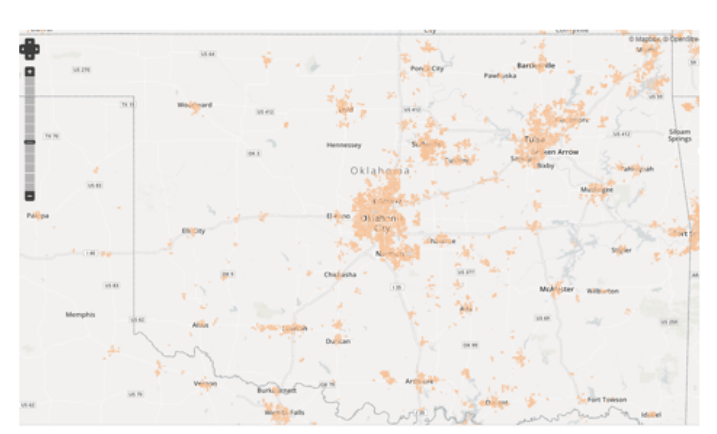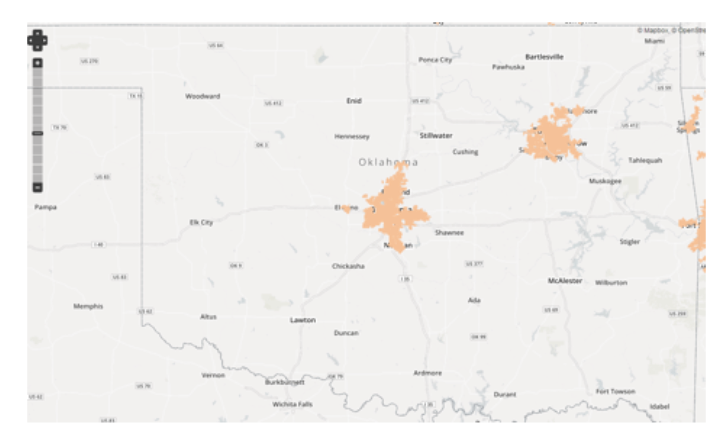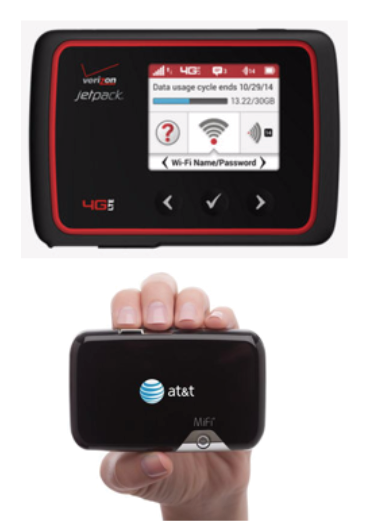Internet Options for Low-Income Households in Oklahoma
Introduction
Internet access is crucial in today’s society – particularly high-speed connections, or “broadband.” Whether for keeping in touch with family and friends, searching / applying for jobs, staying up-to-date on local events or applying for various government programs, having access to the internet is required for many aspects of life. Unfortunately, the cost of maintaining a monthly internet connection exceeds what many Oklahomans can afford. Sixty percent of non-broadband users cite cost as a primary reason they do not have a connection at home, and 33 percent say cost is the most important reason (Horrigan and Duggan, 2015). With average monthly costs ranging from $30 to $100, broadband affordability is a major concern for households across Oklahoma. In fact, a 2015 survey indicates that only 44 percent of Oklahoma households with incomes less than $25,000 have a broadband connection. This is less than half of the 91 percent adoption rate for Oklahoma households with incomes more than $100,000 (Figure 1) and is more than 20 percentage points lower than the overall state average (66 percent). This “digital divide” between low- and high-income households has led to concerns that individuals without home broadband access will be at a disadvantage in today’s increasingly connected world.
Recently, however, several companies and federal programs have initiated efforts focused on helping lower-income households obtain a broadband connection. These efforts range from low-cost options (as low as $5 or $10 / month) from certain providers, to monthly subsidies that can help pay for a broadband connection, to library programs that allow patrons to “check out” internet access for their own house (Table 1). There are options for wireline connections to your house as well as for ‘mobile’ or wireless broadband connections (like data plans for smartphones). This fact sheet will provide an overview of these programs and should serve as a resource for Oklahoma households seeking affordable internet options.
Figure 1. Broadband Adoption Rates for Low- and High-Income Households in Oklahoma.
Source: Current Population Survey, July 2015
Table 1. Quick Look: Summary of Internet Options for Oklahoma Low-Income Households.
| Access from AT&T | Cox Connect2Compete | PCs for People | |
|---|---|---|---|
| Cost | $5 to $10/month | $9.95/month | $10/month |
| Technology | Wireline (0.768 to 10 MBPS) | Wireline (5 to 10 MBPS) | Wi-Fi Device (uses Sprint's cellular network) |
| Qualifying Programs | SNAP | NSLP, SNAP, TANF, Public Housing; Must have K-12 student in house | <200 percent of federal poverty line |
| Other Info | Dependent on AT&T service area | Dependent on Cox Service area | Prepaid plans required; 3-, 6-, 12-month options |
| Scheduled End Date | April 2020 | Two-year Participation limit | N/A |
| Lifeline Broadband Discount | Library Hotspot Checkouts | |
|---|---|---|
| Cost | $9.25/month discount | Free |
| Technology | Wireline (10 MBPS) or mobile broadband (500 MB of data/month) | Wi-Fi Device (can connect up to 15 devices) |
| Qualifying Programs | Public Housing, Medicaid, SNAP, SSI, Tribal programs, <135 percent of federal poverty line | Library Card; one-week loan typical |
| Other Info | Not all providers participate | Not many libraries have these programs |
| Scheduled End Date | N/A | Dependent on library |
- SNAP – Supplemental Nutrition Assistance Program
- NSLP – National School Lunch Program
- TANF – Temporary Assistance for Needy Families
- SSI – Supplemental Security Income
- MBPS – Megabytes Per Second
- MB – Megabytes (of data)
Low-cost Provider Options
Two of the largest internet providers in Oklahoma, AT&T and Cox, have programs that offer reduced prices on broadband connections for low-income households. These programs are known as “Access from AT&T” and “Cox Connect2Compete.” Eligibility for these programs typically depends on participation in federal programs such as the Supplemental Nutrition Assistance Program (SNAP) or the National School Lunch Program (NSLP) and whether or not you have any outstanding debt with that company. The tables and maps of coverage areas below provide more information on these two programs. Speeds are listed in Megabytes Per Second (MBPS). While the download speeds provided are typically slower than the official 2016 FCC definition of “broadband” (25 MBPS), they are significantly faster than dial-up modem access (0.05 MBPS). One especially important aspect of these options is that, unlike promotional offers occasionally made by broadband companies, the costs cited stay the same for the entire length of the program.
- Access from AT&T
Access from AT&T Program Details
Service Area: AT&T’s Wireline technology covers approximately 65 percent of the Oklahoma population (see Figure 2).
Cost: $5 / Month 0.768, 1.5 or 3 MBPS Download
$10 / Month5 MBPS or 10 MBPS Download (where available)
Note: AT&T will automatically give you the fastest speed available in your service area (you cannot apply for a cheaper/slower service, even if it is available).
Technology:
Wireline only (no mobile/smartphone plans).
Digital Subscriber Line (DSL) or Fiber.
Eligibility Requirements:
At least one person in home must receive SNAP benefits
Must live in AT&T’s service area
No outstanding debt for AT&T Fixed Internet service within last six months; no outstanding debt under this program.
Other points: No installation fee.
In-home wireless router included at no cost. Can be used to connect smartphone or tablet, but only in-house.
No deposit required.
To Apply: www.att.com/accessapply/
Step 1: Check for service availability by entering your address.
Step 2: Apply for the program (either online or by phone). Must provide: (1) a copy of the SNAP benefit card showing participant’s name and (2) government-issued ID such as a driver’s license.
Step 3: After application approval, call AT&T to request start of service.
Length of Program: Program runs from April 2016 to April 2020
Figure 2. AT&T Wireline Broadband Service Area in Oklahoma. Source: National Broadband Map (June 2014 data) - Cox Connect2Compete
Cox Connect2Compete Program Details
Service Area: Cox’s wireline technology covers approximately 50 percent of the Oklahoma population (see Figure 3)
Cost: $9.95 per month
5 to 10 MBPS Download
Technology: Wireline only (no mobile / smartphone plans).
Cable Modem.
Eligibility Requirements:
At least one student grades K-12 lives in your household
Household participates in one of the following assistance programs:
National School Lunch program
SNAP
TANF
Family lives in HUD-assisted housing
Have not subscribed to Cox high-speed internet service in last 90 days; no outstanding bills.
Must live in Cox’s service area.
Other points: No installation fee.
In-home wireless router included at no cost. Can be used to connect smartphone or tablet, but only in-house.
No deposit required
To Apply: www.connect2compete.org/cox/
Step 1: Check for service availability by entering your phone number and ZIP code.
Step 2: Apply for the program online. Attest that you have a child attending a K-12 school in your household
Select program that your household participates in (NSLP, SNAP, TANF, Public Housing)
Select city where child attends school/name of school
Attest that you do not have Cox internet in your home, or have not had it in the past 90 days.
Step 3: After application approval, Cox will contact you to begin service.
Length of Program: Eligible families will receive reduced price Internet for two years.
Figure 3. Cox Wireline Broadband Service Area for Oklahoma. Source: National Broadband Map (June 2014 data) - PCs for People
PCs for People is a non-profit organization that offers 4G LTE broadband service for as low as $10 per month through Mobile Beacon. Participants can purchase an easy-to-use wi-fi device that can link to smartphones, laptops, tablets or desktop computers (up to 10 devices). Because these devices use a cellular network, you can take them along as you travel and have a broadband connection anywhere in Mobile Beacon’s coverage area! One of the best parts about PCs for People’s program is that you do NOT have to participate in federal programs like the National School Lunch Program if you can verify you fall below 200 percent of the current federal poverty guidelines. Another impressive feature is that Mobile Beacon’s service plans have no data limits or “throttling down” of speeds, meaning that participants can use the device to search for jobs, take online course, and download/watch videos without worrying about going over their data limit. The downside of this program is that users must prepay for the wi-fi device (a one-time fee around $75) and the months of service selected, resulting in costs ranging from $100 to $195. Mobile Beacon’s 4G LTE service is provided on the 4G LTE network of a national carrier. The LTE download speeds are up to 25 Mbps and routinely offer 6 to 8 Mbps. For instructions on how to check if your area has coverage, visit www.mobilebeacon.org/coverage.
PCs for People Program Details
Service Area: Mobile Beacon’s service currently covers approximately 88 percent of the Oklahoma population.
Cost: Prepaid only (includes $75 wi-fi device):
3months – $114.95
6 months – $149.95
12 months – $194.95
Technology: Cellular (wireless) technology.
Eligibility Requirements: recipients must provide proof that they are below the 200 percent of federal poverty line OR are currently enrolled in an income-based government program. PCs for People requires that recipients provide proof of ongoing eligibility at least annually.(http://www.pcsforpeople.com/recipients/eligibility)
Other points: Unlimited 4G LTE service where available.
No throttled speeds or data caps.
To Apply: http://www.pcsforpeople.com/recipients/low-cost-internet.
Length of Program: No scheduled end date.
Figure 4. Example of Mi-fi device as part of PCs for People low-cost Internet service. - Federal Subsidy Program – Broadband Lifeline
While the previous section focused on low-cost broadband options for Oklahoma residents, a new federal program will provide a $9.25 monthly subsidy (i.e. discount) for eligible low-income subscribers who purchase a monthly broadband plan. Unlike the options offered by AT&T and Cox (which are only for wireline connections), the Lifeline subsidy is available for either wireline connections or mobile broadband connections (i.e. data plans for smartphones).
The Lifeline program has been around since 1985, but has historically provided discounts for phone service to qualifying low-income consumers. As of December 2016, the Lifeline program will include broadband internet access. It is important to note that Lifeline recipients will be allowed to receive discounts on either phone service (i.e. landline or cellphone voice plans) or broadband service (wireline or mobile broadband),but cannot receive two discounts. Participants are allowed to use the discount for a broadband and voice bundle, such as those provided by many smartphone companies, but will only receive a total subsidy of $9.25 per month.
Providers who offer Lifeline broadband discounts must provide a minimum level of service:
Wireline service (DSL, fiber, cable modem) must offer at least 10 MBPS download/1 MBPS upload and have a usage capacity of at least 150 gigabytes (GB) per month.
However, providers with slower service (less than 10 MBPS) can still become Lifeline providers and offer the subsidy at their lower speed.
Mobile broadband service must offer either 3rd or 4th generation cellular technology (3G or 4G networks). Plans must offer at least 500 MB of monthly data as of December 2016; that amount will raise to 2 GB per month by December 2018.
Lifeline Broadband Eligibility
Households are eligible for a Lifeline broadband discount if someone in the residence is currently enrolled in one or more of the following federal programs:
Federal Public Housing Assistance
Medicaid
SNAP (Supplemental Nutrition Assistance Program)
SSI (Supplemental Security Income)
Live on Tribal lands AND participate in:
Head Start
Bureau of Indian Affairs General Assistance
Tribal TANF (Temporary Assistance for Needy Families)
Food Distribution Program for Indian Reservations
Earn less than 135 percent of the federal poverty guidelines (check for your household size here: https://www.lifelinesupport.org/do-i-qualify/)
In 2016, this was $16,038 for a single person household and $32,805 for a four-person household.
Lifeline Broadband Rules
Only one Lifeline benefit is permitted per household. Also, subscribers must recertify their eligibility each year (participants receive a notice reminding them of this and providing instructions on how to recertify). However, as long as someone in the household satisfies the eligibility requirements, there is no limit on how long the household can receive the discount.
Lifeline Broadband Program Process
Eligible consumers will select from a participating Lifeline carrier in Oklahoma (such as, potentially, AT&T or Cox). A list of participating Lifeline broadband carriers will begin being populated in December 2016 as providers roll out their offers. Each individual carrier will have procedures for formally applying and then verifying the applicants. The carrier will then deliver the discounted service to the customer on a monthly basis and will file for reimbursement from the federal agency in charge (USAC) for the discounted services provided. Note that carriers are not required to participate in the Lifeline program. So the company you currently use for internet service may not be a Lifeline broadband participant. A national registry for broadband Lifeline carriers is in development, but will likely not be available until 2018.
The Federal Communications Commission has indicated that low-cost offers (such as Access from AT&T or Connect2Compete from Cox) cannot be Lifeline broadband offers when the original low-cost offer is part of a merger agreement. This is the case with AT&T, which agreed to the Access program as part of its merger with DirectTV in 2015. You are not able to combine a low-cost offer from AT&T with a $9.25 discount from the Lifeline program. - Library Hotspot Programs
Libraries have long been a common source of internet access for low-income households across the nation. This has typically required patrons to make a trip to the library to use their computers or wireless connection. Recently, however, some libraries across the nation have begun programs that “loan out the internet” by allowing patrons to check out mobile hotspot devices. These devices use cellular networks (the same ones used by smartphones) to provide access to the internet. The devices can be used inside a home, taken to other locations such as a restaurant or community center or even taken with the patron on road trips. As long as the cellular network used by the hotspot (for example, Sprint or AT&T) has service in that area, it will provide broadband access. The hotspots can be used to hook up multiple devices to the internet, such as tablets, smartphones or laptops. Multiple users (up to 15) can log on to a single hotspot device.
Libraries have different policies about who can check out these devices and how long the loan period is. However, most libraries with a program will allow adults with a valid library card to check out the device, and loan periods usually range between one week and one month. These programs are currently more popular in urban locations such as Tulsa; however ongoing research has suggested such programs are viable in rural communities (IMLS, 2016). Ask about the program in your local library. If it is unavailable, express an interest and direct the library personnel to information about similar programs (available in the reference section of this document).
Figure 5. Examples of mobile hotspot devices loaned out by libraries.
Summary
As the Internet becomes an integral part of the lives of most citizens, those without access risk falling behind. There are several low- or no-cost options available for low-income households that would like to have their own broadband connection. The best choice will depend on the providers available in the area and household preference regarding the type of technology they would like to use.
References
Connected Nation. 2016. “Policy Brief: FCC Releases First Details of Lifeline Broadband Program.” Available online: http://www.connectednation.org/sites/default/files/bb_pp/05052016_lifeline_modernization_order.pdf
Horrigan, J. and M. Duggan. 2015. “Home Broadband 2015.” Pew Research Center. Available online: http://www.pewinternet.org/2015/12/21/2015/Home-Broadband-2015/
Institute for Museum and Library Services (IMLS). 2016. “Starting a Mobile Hotspot Lending Program.” Available online: http://sites.utexas.edu/imlsedgesgrant/files/2016/09/How-to-Hotspot.pdf
Tulsa Library. 2016. “Library Offers Wireless Hotspots Available for Checkout.” Available online: https://www.tulsalibrary.org/hotspot
Universal Service Administrative Company. 2015. “Lifeline Fact Sheet.” Available online: https://www.hudexchange.info/resources/documents/Lifeline-Fact-Sheet.pdf
Brian Whitacre
Professor and Extension Economist




